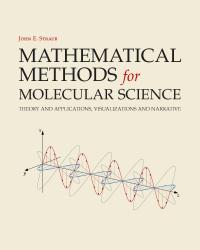Mathematical Methods for Molecular Science
Mathematical Methods for Molecular Science
By: John E. Straub
Straub’s stunning new text is an excellent choice for a one-semester course on mathematical methods, an affordable supplement for physical chemistry courses, or a self-study guide.
For all sales outside of the United States, please contact Felicity Henson, fhenson@aip.org
Title information
This brilliant new text by John Straub (Boston University) is designed to bridge the “mathematics knowledge gap” between what is commonly known by students after completing a year of introductory calculus, and what is required for success in the physical sciences and in physical chemistry courses. Key concepts from the introductory calculus sequence are reviewed and carefully selected topics in multivariate calculus, probability and statistics, ordinary differential equations, and linear algebra are explored. Additional chapters cover advanced topics, including partial differential equations, Fourier analysis, and group theory. Engaging narratives, fully worked examples, hundreds of colorful visualizations, and ample end-of-chapter problems with complete answers combine to make this stunning new text an excellent choice for a one-semester course on mathematical methods, as a supplement for courses in physical chemistry, or as a self-study guide. Ancillaries for adopting faculty include in-class worksheets, sample exams, and an answer manual.
Contents
Introduction
1 Functions and coordinate systems
2 Complex numbers and logarithms
3 Differentiation in one and many dimensions
4 Scalars, vectors, and vector algebra
5 Scalar and vector operators
6 Extremizing functions of many variables
7 Integration in one and many dimensions
8 Sequences, series, and expansions
9 Fundamentals of probability and statistics
10 Ordinary differential equations
11 More ordinary differential equations
12 Partial differential equations
13 Fourier series, Fourier transforms, and harmonic analysis
14 Matrices and matrix algebra
15 Eigenvalues and eigenvectors
16 Geometric transforms and molecular symmetry
Bibliography
Index
Colophon
|
John Straub has written an excellent textbook for undergraduates who have taken Calculus II and want to major in chemistry, biology, or physics. I used this wonderful book as the primary text in the one-semester course “Math for Chemistry” we teach at NYU. Because the book covers many math topics important for scientific applications, it allows instructors to select and include as many areas as needed and as time permits. The figures and problems help illustrate and expand upon key concepts. It is evident that the author has poured much love and craft into this beautiful book. This excellent book is unique in its accessibility as well as depth. It represents a great and self-contained pathway to teach mathematical skills to students of molecular sciences. I used it in my physical chemistry course along with textbooks by McQuarrie and Atkins, but found that Straub’s book was “the great equalizer” that made those textbooks equally accessible to all students in my course, including biochemistry and materials science majors. The book clearly reflects Straub’s passion for sharing knowledge and is one to stand the test of time. This is a fantastic resource for students in undergraduate physical chemistry and graduate statistical mechanics and quantum chemistry. It provides students with a quick way to learn the tools they need, and demystifies math in a way that will give students confidence. The book has a lot of interesting problems for practice and is beautifully written. |
John E. Straub
John E. Straub is Professor of Chemistry at Boston University. He received his B.S. in Chemistry from the University of Maryland at College Park, where he worked with Millard H. Alexander, and his Ph.D. in Chemical Physics from Columbia University, where he worked with Bruce J. Berne. He was a NIH Postdoctoral Fellow at Harvard University, where he worked with Martin Karplus. He has been a visiting professor at The Hebrew University of Jerusalem, Nagoya University in Japan, Montana State University, and Université Grenoble Alpes. His research in theoretical and computational molecular science explores the dynamics and thermodynamics of proteins, membranes, and complex molecular assemblies, as well as algorithmic development for optimization, enhanced sampling, and long-time dynamics. He has served as President of the Telluride Science Research Center (TSRC), as Phi Beta Kappa National Visiting Scholar, and as Associate Editor of The Journal of Chemical Physics.

